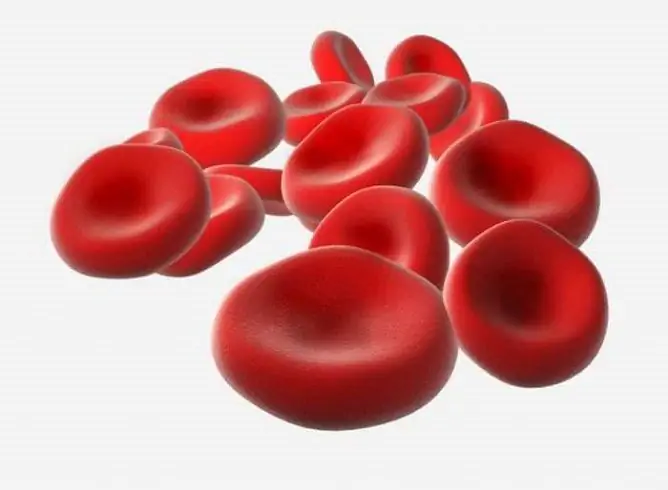- Author Rachel Wainwright [email protected].
- Public 2023-12-15 07:39.
- Last modified 2025-11-02 20:14.
RDW in a blood test - what is it?
The content of the article:
- Erythrocytes, their functions in the body, main indicators
- How to properly prepare and take a general blood test
- Decoding RDW in a blood test: the norm in women and men
- Reasons for deviation from the norm of the RDW indicator in the blood test
The distribution width of red blood cells by volume (RDW, from red cells distribution width) is an erythrocyte index that allows you to determine the heterogeneity of the cell volume in peripheral blood.
Erythrocytes, their functions in the body, main indicators
Erythrocytes, or red blood cells (RBCs), are red blood cells, biconcave disc-shaped blood cells without a nucleus. The shape of the erythrocyte allows the cell to deform as it moves through the small-caliber blood vessels. The main function of erythrocytes is to transport oxygen from the lungs to tissues and organs, and from them - carbon dioxide to the lungs. Erythrocytes are formed in the bone marrow and destroyed in the spleen; the average life of cells is 120 days. In newborns, the size of red blood cells is larger than in adults.

A condition in which abnormal red blood cells are detected in the blood is called anisocytosis
A physiological increase in the number of red blood cells is observed in children during the first days of life, with frequent stress, intense physical exertion, insufficient nutrition or starvation, with prolonged clamping of the limb with a tourniquet during blood sampling for blood tests. Physiological reduction in the number of red blood cells occurs immediately after a meal, between 17:00 and 07:00 and in the case of taking blood from the patient in the supine position.
In the blood, in addition to normal erythrocytes, there may be cells that differ in size - larger (macrocytes) or smaller (microcytes) red blood cells. A condition in which more than 50% of macrocytes are in the blood is called macrocytosis. In the presence of 30-50% of microcytes, microcytosis is diagnosed. The appearance in the blood of erythrocytes differing in volume is called anisocytosis, the degree of which can be determined by the RDW index.
Erythrocyte indices are determined during a general (clinical) blood test. The counting is carried out using an automatic hematological analyzer, according to the appropriate formulas and / or in a stained blood smear under a microscope when calculating the leukocyte formula. The erythrocyte indices in the general blood test, in addition to RDW, include MCV (average erythrocyte volume), MCH (average hemoglobin content in an erythrocyte), MCHC (average hemoglobin concentration in erythrocyte mass).
How to properly prepare and take a general blood test
Complete blood count is a basic study, which is carried out according to the following indications:
- prevention, with the aim of early detection of probable pathologies;
- diagnosis of diseases;
- control of ongoing therapy;
- before surgery;
- monitoring the course of pregnancy.
A general blood test includes counting the number of blood cells (erythrocytes, leukocytes, platelets), determining the concentration of hemoglobin, hematocrit, erythrocyte and platelet indices, erythrocyte sedimentation rate. A detailed blood test includes the calculation of the leukocyte formula.
As a preventive measure, a general blood test should be taken annually. Persons from risk groups (with burdened heredity, the presence of chronic diseases, occupational hazards, during pregnancy, etc.) may need to conduct this study more often - 2 times a year, 1 time in 3 months, and sometimes more often.
Blood for a detailed general analysis, which includes the determination of erythrocyte indices, including the RDW index, is usually taken from a vein. In some cases, capillary blood may be drawn from a finger. Blood is taken in the morning on an empty stomach, at least eight hours after the last meal. Before donating blood, you should avoid mental and physical overload, stop smoking. It is advisable not to carry out medical procedures the day before.
Decoding RDW in a blood test: the norm in women and men
The indicator RDW-CV (CV - coefficient of variation) displays the relative width of distribution of red blood cells by volume, i.e. how much the volume of red blood cells differs from the average, and is measured as a percentage. The index is influenced by the MCV index, fluctuations in which lead to an increase in the RDW-CV. The norm of this indicator for adult men and women is 11-15%. In infants up to 6 months, the RDW-CV rate is 15-19%. In children over 6 months, the norm corresponds to that for adults.
When decoding RDW-SD in a blood test (SD - standard deviation), it is taken into account that this indicator does not depend on the MCV index. This index shows how dissimilar the red blood cells in the blood are in terms of volume and size, that is, what is the difference between small and large cells. The RDW-SD rate is 42 ± 5 fl.

Determination of the RDW index is carried out during a detailed clinical blood test
The RDW-SD index is more accurate in the case of a small population of micro- or macrocytes, and the DW-CV index more accurately reflects the overall changes in the volume of red blood cells.
Reasons for deviation from the norm of the RDW indicator in the blood test
An elevated level of RDW means that there is heterogeneity, that is, dissimilarity in the volume of the population of red blood cells, and can also mean the presence of several populations of red blood cells in the blood (for example, after blood transfusion).
If in the blood test the RDW-CV is increased by 15% or more, this indicates the presence of red blood cells of different volumes in the blood, the higher this index, the greater the difference in the volume of red blood cells. A falsely overestimated RDW-CV result may be due to the presence of cold agglutinins in the patient's blood sample - antibodies that cause aggregation, i.e., clumping of red blood cells when exposed to low temperatures.
An increase in RDW is observed in the following pathologies:
- microcytic anemia;
- hemoglobinopathy;
- lack of iron, vitamin B 12 and / or folic acid in the body;
- an increase in the number of leukocytes in the blood (above 50 × 10 9 / l);
- agglutination of erythrocytes;
- hemolytic crisis;
- malignant neoplasms (especially with metastases to the bone marrow);
- myelodysplastic syndrome;
- myelofibrosis;
- Alzheimer's disease;
- cardiovascular diseases;
- alcoholism;
- lead poisoning.
Increased blood RDW values can also be obtained immediately after surgery or blood transfusion.
The index remains within the normal range or slightly reduced in acute blood loss, chronic diseases, hemolytic anemia outside the crisis, heterozygous beta-thalassemia. If the RDW index is lowered, this often means the need to retake a complete blood count.
When decoding the general blood test in general and the RDW indicator in particular, the values of the erythrocyte index MCV are taken into account:
- normal RDW + reduced MCV - after blood transfusion, post-traumatic splenectomy, chemotherapy, hemorrhages, thalassemia, cancer;
- decreased MCV + increased RDW in the blood test - iron deficiency, fragmentation of red blood cells, beta thalassemia;
- increased MCV + normal RDW - with liver disease;
- increased MCV + increased RDW - in case of hemolytic anemia, lack of vitamin B 12, the presence of cold agglutinins in the blood sample, as well as during chemotherapy.
Additional research is needed when an RDW result is obtained that is outside the reference range.
YouTube video related to the article:

Anna Aksenova Medical journalist About the author
Education: 2004-2007 "First Kiev Medical College" specialty "Laboratory Diagnostics".
Found a mistake in the text? Select it and press Ctrl + Enter.






